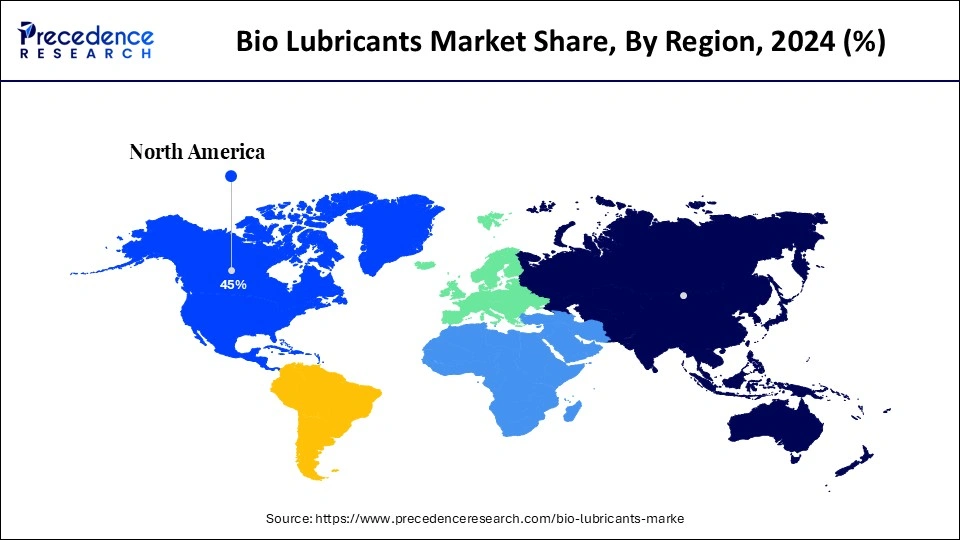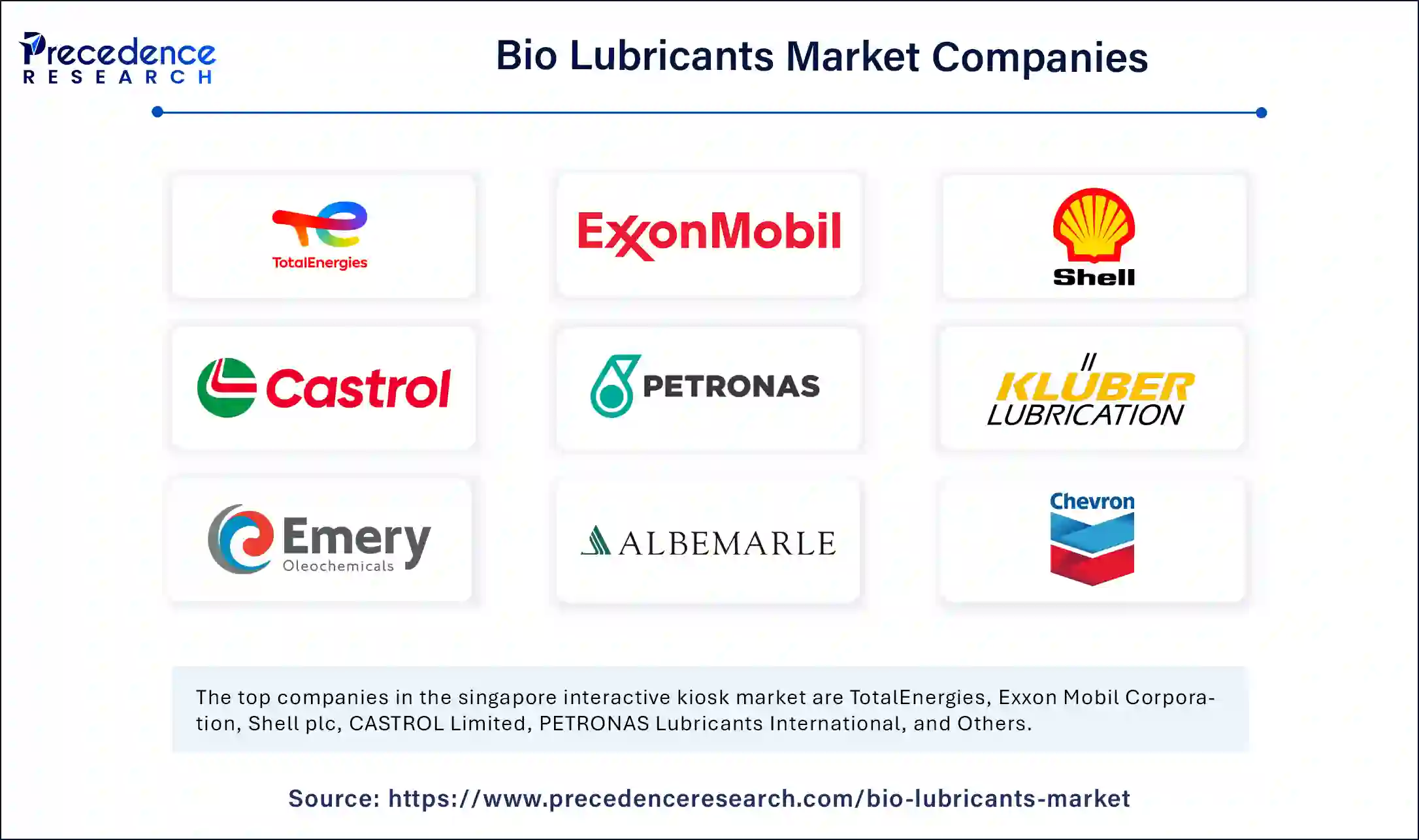April 2025
The global bio lubricants market size is calculated at USD 3.60 billion in 2025 and is forecasted to reach around USD 5.45 billion by 2034, accelerating at a CAGR of 4.73% from 2025 to 2034. The North America market size surpassed USD 1.55 billion in 2024 and is expanding at a CAGR of 4.81% during the forecast period. The market sizing and forecasts are revenue-based (USD Million/Billion), with 2024 as the base year.
The global bio lubricants market size was estimated at USD 3.44 billion in 2024 and is predicted to increase from USD 3.60 billion in 2025 to approximately USD 5.45 billion by 2034, expanding at a CAGR of 4.73% from 2025 to 2034. The growth of the market is driven by increasing environmental regulations, rising demand for sustainable alternatives, and advancements in bio-based lubricant technology.

With the incorporation of cutting-edge technologies, including Artificial Intelligence, in research and the production of bio-lubricants, production processes can be improved. Machine learning models analyze large datasets, which help enhance the viscosity, oxidation, stability, and biodegradability of formulations to develop high-performance bio-lubricants for harsh environments. AI-driven monitoring systems ensure consistency in manufacturing. Moreover, AI helps manufacturers predict future demand and optimize supply chain management.
The U.S. bio lubricants market size was exhibited at USD 1.08 billion in 2024 and is projected to be worth around USD 1.75 billion by 2034, growing at a CAGR of 4.94% from 2025 to 2034.

North America dominated the bio lubricants market with the largest share in 2024 and is expected to sustain its position in the near future. This is mainly due to strong regulatory support and increased awareness of environmental sustainability. Regional players like ExxonMobil and Chevron strongly focus on developing high-performance bio-lubricants. The growing use of electric vehicles and the need for environmentally friendly vehicle lubricants further bolster the market. The presence of a well-established industrial sector and increasing developments of innovative lubricant formulations also support long-term growth.
The bio lubricants market in the Asia Pacific is expected to grow at the fastest rate in the upcoming period, driven by rapid industrialization, urbanization, and the expansion of the automotive and manufacturing sectors. The need for bio-based lubricants is rising because nations like China, Japan, and India are moving toward sustainable industrial practices. Growing consumer awareness and government programs supporting environmentally friendly substitutes are speeding up market growth. Furthermore, the production of bio-lubricants is more economical due to the abundant availability of raw materials like soybean and palm oil. The rising need for hydraulic fluids, engine oils, and industrial lubricants due to the increasing automotive production and expanding infrastructure projects will further propel market expansion.

Europe is expected to experience notable growth in the bio lubricants market due to its strong commitment to sustainability and stringent environmental policies. The European Union has been at the forefront of promoting bio-based products, leading to the widespread adoption of bio-lubricants in the automotive, marine, and industrial sectors. To improve the effectiveness of bio-based lubricants, nations like France and Germany are making significant investments in research and development. It is also simpler for businesses to implement sustainable practices in the area because of its well-established recycling and waste management infrastructure. The presence of major automakers and industrial machinery manufacturers further solidifies Europe's position as a key region for future market developments.
The bio lubricants market is expanding rapidly, mainly due to rising environmental regulations. As environmental regulations become stringent, the demand for sustainable alternatives increases. The growing awareness among consumers about the availability of bio-based alternatives to petroleum-based products is boosting the growth of the market. The machinery, automotive, and marine sectors are shifting toward bio-lubricants due to their biodegradable and less toxic nature. Bio lubricants perform better in harsh environments, making them suitable for industrial applications. Market players are investing heavily in R&D to increase product efficiency and broaden applications.
| Report Coverage | Details |
| Market Size by 2034 | USD 5.45 Billion |
| Market Size in 2025 | USD 3.60 Billion |
| Market Size in 2024 | USD 3.44 Billion |
| Market Growth Rate from 2025 to 2034 | CAGR of 4.73% |
| Dominating Region | North America |
| Fastest Growing Region | Asia Pacific |
| Base Year | 2024 |
| Forecast Period | 2025 to 2034 |
| Segments Covered | Source, Application, End-use, and Regions. |
| Regions Covered | North America, Europe, Asia-Pacific, Latin America, and the Middle East & Africa. |
Stringent Environmental Regulations and Sustainability Goals
Governments all over the world are implementing strict environmental laws to lower pollution and promote sustainability, which is a major factor driving the growth of the bio lubricants market. Several nations have set their sustainability goals. To meet climate goals, for example, the renewable energy directive of the European Union promotes the use of bio-based products. The demand for sustainable products, including bio-lubricants, has increased in the U.S. due to the USDA BioPreferred Program that focuses on increasing the production and use of bio-based products. With rising energy prices, many companies are shifting toward bio-lubricants.
Rising Demand for Eco-friendly Alternatives
Industries are increasingly seeking nontoxic and biodegradable lubricants due to the rising concerns about environmental sustainability. For instance, the German multinational FUCHS SE provides the Palnto line of biodegradable products to meet this demand. The company is the largest independent lubricant manufacturer in the world, thanks to its dedication to sustainability. The demand for bio-lubricants in household and personal vehicle applications is rising as a result of increased environmental consciousness among consumers. Businesses that use bio-lubricants in manufacturing and logistics are gaining a competitive edge by meeting sustainability regulations. Additionally,
High Production Costs
Compared to traditional petroleum-based lubricants, the cost of producing bio-lubricants is much higher because of the costly raw materials and intricate refining procedures. Furthermore, many regions have not achieved economies of scale, which keeps production costs high. The higher costs associated with obtaining certifications such as the EU Ecolabel further increase the financial burden for manufacturers. Additional factors contributing to the higher production cost include the upfront expenditure needed to establish bio-lubricant production facilities, which require sophisticated refining and processing technologies. Due to the cost barrier, SMEs are deterred from entering the market, reducing competition and limiting innovation.
Limited Availability of Raw Materials
The limited availability of raw materials hinders the growth of the bio lubricants market. Raw materials like vegetable oils, rapeseed, soybean, and palm oil are the main sources of bio-lubricants. However, these materials are susceptible to seasonal fluctuations and geopolitical conflict. For instance, Cargill Inc., a significant participant in the bio-based chemicals industry, has encountered difficulties in ensuring a consistent supply of raw materials because of the variation in agricultural yields. Unpredictable supply chain distributions resulting from climate change make this problem even worse. Due to the growing concerns about deforestation associated with palm oil production, various nations' governments have imposed stringent regulations on raw material outsourcing. Due to increased competition from the biofuel industry's high usage of these oils, lubricant producers now find it more difficult to obtain reasonably priced raw materials. Due to this difficulty long-term pricing and production planning are challenging, which could cause market instability.
Rising Adoption in the Automotive Industry
Bio-lubricants are in high demand as the automotive industry emphasizes lowering carbon emissions. Automotive manufacturers are seeking biodegradable lubricants for cooling, braking, and transmission systems in light of the growing popularity of electric vehicles (EVs) and sustainable mobility options. Castrol BP has already released a line of bio-lubricants designed specifically for hybrid and electric cars. The need for bio-lubricants in the production and upkeep of vehicles is anticipated to increase as major automakers strive for net-zero emissions. Additionally, government initiatives that encourage the use of environmentally friendly automotive fluids are pushing businesses and consumers to move away from petroleum-based substitutes.
Improvements in Bio-lubricant Formulations
Continuous research and development efforts led to the development of better bio-lubricant formulations with increased performance, oxidation, stability, and compatibility. High-performance bio-based lubricants for industrial use were recently introduced by Kraton Corporation, improving the robustness and effectiveness of machinery. Bio-lubricants are becoming more competitive with conventional alternatives thanks to advancements in synthetic esters and nanotechnology, which are also increasing viscosity and temperature resistance. The bio lubricants market is expected to grow rapidly in the foreseeable future as more industries are demanding high-performance bio-based lubricants and fuel. Bio lubricants will be more widely accepted across industries due to their longer shelf life and slower degradation rates.
The vegetable oil segment dominated the bio lubricants market with the largest share in 2024. This is mainly due to its exceptional lubricating qualities and biodegradability. Companies like Cargill Inc. and Novvi LLC have developed bio-lubricants from vegetable oils. Lubricants made for vegetable oil ensure high performance while meeting strict environmental standards. Vegetable oil possesses high viscosity and is less expensive than others, making it suitable for bio-lubricants.
The animal oil segment is anticipated to grow at a rapid pace in the coming years. Animal oil is derived from animal fats or waste. Bio-lubricants made from animal oil are suitable for a range of equipment and applications and provide superior lubrication, improving the performance of equipment. Several companies are seeking to develop lubricants made from animal fat to reduce dependency on nonrenewable resources that will still provide efficient lubrication. Producing bio-lubricants from animal oil is now more viable due to the growing emphasis on waste utilization and the advancements in waste processing methods.
The automotive segment held the largest share of the bio lubricants market in 2024. This is mainly due to the rise in demand for low-VOC engine oil. The automotive industry produces grease engine oils and transmission fluids. In response to the industry's need for high-performance, environmentally friendly solutions, major oil companies like ExxonMobil Corporation and Shell plc have increased their range of products by adding bio-lubricants designed specifically for automotive applications. Furthermore, TotalEnergies provides a selection of bio-based lubricants intended to improve vehicle performance while lessening their negative effects on the environment. The automotive industry is adopting bio-lubricants due to strict emission regulations and rising consumer awareness of environmentally friendly products.
The industrial segment is expected to grow at the fastest rate in the market during the forecast period due to the rising usage of lubricants, especially in applications such as metalworking and hydraulic fluids. A wide variety of bio-lubricants are available for hydraulic oils and metalworking fluids. Various companies are expanding their eco-friendly lubricants line for industrial machinery and equipment. The growing emphasis on sustainability and strict regulations to reduce emissions from industrial operations are expected to drive segmental growth.
The industrial segment dominated the bio lubricants market with the largest share in 2024. This is mainly due to the widespread application of bio-lubricants in vehicle and heavy machinery manufacturing processes. Bio-lubricants for industrial use guarantee that equipment runs effectively. Bio-based industrial lubricants serve a range of industries, including construction and manufacturing. Reducing environmental impact and adhering to laws that support sustainable practices are the main reasons the industrial sector is adopting bio-lubricants.
The commercial transportation segment is expected to expand at the highest CAGR during the forecast period. The commercial transportation industry is quickly embracing bio-lubricants to meet environmental regulations and sustainability goals. Intending to lower carbon emissions and improve engine performance, companies such as TotalEngine have created bio-lubricant products, especially for commercial fleets. With an emphasis on reducing emissions and increasing fuel efficiency, several companies are providing bio-based lubricants for trucks and buses. The adoption of bio-lubricants is primarily driven by the transportation industry's drive for greener alternatives and increased awareness of environmental issues.

By Source
By Application
By End-use
By Region
For inquiries regarding discounts, bulk purchases, or customization requests, please contact us at sales@precedenceresearch.com
No cookie-cutter, only authentic analysis – take the 1st step to become a Precedence Research client
April 2025
August 2024